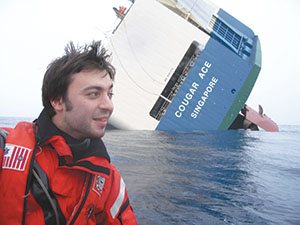HELAINE OLEN
For our cover story, Helaine Olen examines radio host Dave Ramsey’s rise from bankruptcy to become America’s foremost anti-debt guru (“The Prophet”). The author of Pound Foolish: Exposing the Dark Side of the Personal Finance Industry, New York-based Olen has followed Ramsey’s show for years. While she finds his advice problematic to say the least, there’s something compelling about the program. “It’s always his callers who stand out to me,” she says. “Many of them are using money as a proxy to discuss other woes—marital problems, unsettled business with parents or siblings. Ramsey is always empathetic in these calls, and allows people to speak as long as they need.”
CHARLES HOMANS
A onetime environmental reporter in the Aleutian Islands (and now the executive editor of The Atavist), Charles Homans was only “dimly aware that there had been Soviet whaling in the region.” That was before he came across Yulia Ivashchenko’s translation of a Soviet scientist’s research journal—an account of an epic and clandestine mid-20th-century campaign of slaughter, and the basis for “The Vanishing.” “Every story about humans and the natural world is on some level a story about ideology, whether it’s religious, political, or economic,” he says. “This is a ghoulishly extreme example of that.”
Charles Homans. (PHOTO: COURTESY OF CHARLES HOMANS)

DAVID DAYEN
David Dayen’s interest in the future of Social Security (“Get Serious”) was inspired in part by the travails of his 90-year-old grandmother. “Medical costs have eroded her savings over the past decade, to the point that she really has nothing left,” says the journalist (The American Prospect, The New Republic, Salon). “She lives on a rigidly fixed income, and support from my parents gets her through. Obviously, my grandmother could do with a bump in Social Security benefits. Like the rest of the nation.”
GRAEME WOOD
Graeme Wood (“Death at the Summit”) never had much use for the political prognosticators on TV. “Any idiot can see that their predictions are terrible and biased. So by comparison, the accuracy of prediction markets like Intrade impressed me. But they also left me surprisingly cold.” After following Intrade’s ups and downs, Wood was amused to find himself appreciating the screaming matches of cable news for the first time. “Accuracy is overrated,” he says, “and showmanship is underrated.” A contributing editor at The Atlantic, Wood lives in Oakland, California.
CHRIS V. NICHOLSON
“The idea of computers making art is divisive and emotionally fraught,” says Chris V. Nicholson, a Montana-born, Paris-based writer (Businessweek, The International Herald Tribune). In “Rise of the Robot Artist,” Nicholson reports on an array of machine-generated creations. Scientists view computational creativity as a grand experiment that will provide more art for more people, he says, but the audience for art rejects it. “They don’t feel connected to the databases and variables that make software work. As society is increasingly automated, art is regarded as the last refuge of the human.”
MARK WAGNER
“Dave Ramsey is often pictured with scissors, cutting up credit cards,” notes the Pennsylvania-based currency collage artist Mark Wagner, who illustrated our cover story (“The Prophet”). “This strikes a chord with me, as I spend a fair amount of my time using scissors to cut up dollar bills.” Wagner’s work has been exhibited at the Metropolitan Museum of Art, the Museum of Modern Art, and the National Portrait Gallery. He has also contributed images to Harper’s, The Wall Street Journal, and Requiem for the American Dream—a soon-to-be-released documentary on Noam Chomsky and the demise of the middle class.




